 W
WDavid is described in the Hebrew Bible as the third king of the United Monarchy of Israel and Judah, becoming king after Ish-bosheth. In the Books of Samuel, David is a young shepherd who gains fame first as a musician and later by killing the enemy champion Goliath. He becomes a favorite of King Saul and a close friend of Saul's son Jonathan. Worried that David is trying to take his throne, Saul turns on David. After Saul and Jonathan are killed in battle, David is anointed as King. David conquers Jerusalem, taking the Ark of the Covenant into the city, and establishing the kingdom founded by Saul. As king, David commits adultery with Bathsheba, leading him to arrange the death of her husband Uriah the Hittite. David's son Absalom schemes to overthrow David. David flees Jerusalem during Absalom's rebellion, but after Absalom's death he returns to the city to rule Israel. Because David shed much blood, God denies David the opportunity to build the temple. Before his peaceful death, he chooses his son Solomon as successor. He is honored in the prophetic literature as an ideal king and the forefather of a future Messiah, and many psalms are ascribed to him.
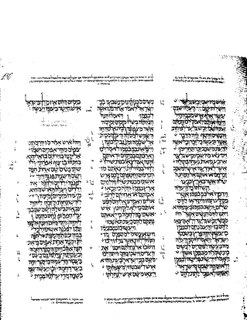 W
W2 Samuel 23 is one of the final chapters of the Books of Samuel in the Hebrew Bible. It contains a prophetic statement described as the "last words of David" and details of the 37 "mighty men" who were David's chief warriors.
 W
WAbishag was a beautiful person of Shunem, who, when brought to David, was a na'arah, which indicates youth and/or virginity, but not necessarily both. According to the Hebrew Bible, she was chosen to be a helper and servant to king David in his old age. Among Abishag's duties was to lie next to David and pass along her animal heat and vigor ,, while not having sex with him.
 W
WAl-Anbiyāʼ, properly pronounced: Al-Ambiyāʼ is the 21st chapter (sūrah) of the Quran with 112 verses (āyāt). Regarding the timing and contextual background of the supposed revelation, it is an earlier "Meccan surah", which means it is believed to have been revealed in Mecca, instead of later in Medina. Its principal subject matter is prophets of the past, who also preached the same faith as Muhammad.
 W
WAmasa (עמשא) or Amessai is a person mentioned in the Hebrew Bible. His mother was Abigail, a sister of King David and Zeruiah. Hence, Amasa was a nephew of David, and cousin of Joab, David's military commander, as well as a cousin of Absalom, David's son. David calls him "my bone and my flesh". Amasa's father was Jether who was also called Ithra.
 W
WAl-Baqarah is the second and longest chapter (sūrah) of the Quran. It consists of 286 verses (āyāt), 6,201 words and 25,500 letters.
 W
WAccording to 2 Samuel, the Battle of the Wood of Ephraim was a military conflict between the rebel forces of the formerly exiled Israelite prince Absalom against the royal forces of his father King David during a short-lived revolt.
 W
WBethlehem is a city located in the central West Bank, Palestine, about 10 km south of Jerusalem. Its population is approximately 25,000, and it is the capital of the Bethlehem Governorate. The economy is primarily tourist-driven, peaking during the Christmas season, when Christians make pilgrimage to the Church of the Nativity. The important holy site of Rachel's Tomb is located at the northern entrance of Bethlehem, though not freely accessible to the city's inhabitants due to the Israeli West Bank barrier.
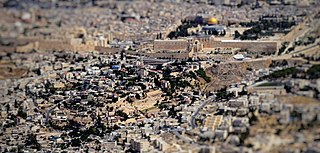 W
WThe City of David, called in Arabic: وادي حلوه, Wadi Hilweh, a neighborhood of Silwan, is a Palestinian Arab village intertwined with an Israeli settlement, and the archaeological site which is speculated to constitute the original settlement core of Bronze and Iron Age Jerusalem.
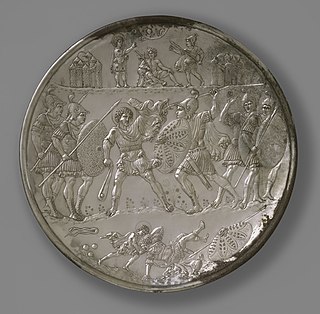 W
WThe David Plates are a set of nine silver plates, in three sizes, stamped between 613 and 630. The plates were created in Constantinople, each depicting a scene from the life of the Hebrew king David, and associated with the reign of Emperor Heraclius (610-641). Following their discovery in Karavas in 1902, the David Plates have been considered key additions to early Byzantine secular art. It is also noted that the David Plates were found amongst the Second Cyprus Treasure. Casual laborers from the village of Karavas found the David Plates as they were quarrying the ruins for construction stones. The finders, however, failed to report what they had discovered to the Cypriot authorities. When authorities learned of their taking they confiscated three of the David Plates alongside a pair of cross-monogram plates, and other jewelry held today in the Museum of Antiquities in Nicosia. The rest of the discovery was smuggled from Cyprus and traded to a dealer located in Paris. Most of this hoard was bought by J. Pierpont Morgan and was later given to the Metropolitan Museum of Art in New York City by his heirs in 1917, where they currently remain.
 W
WDavid's Mighty Warriors are a group of 37 men in the Hebrew Bible who fought with King David and are identified in 2 Samuel 23:8–38, part of the "supplementary information" added to the Second Book of Samuel in its final four chapters. The International Standard Version calls them "David's special forces".
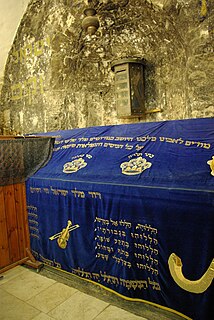 W
WKing David's Tomb is a site considered by some to be the burial place of biblical king David of Israel, according to a Christian, Jewish, and Muslim tradition beginning in the 9th or 12th century CE, some two millennia after the traditional time of David. The majority of historians and archaeologists do not consider the site to be the actual resting place of King David.
 W
WThe Hebrew Bible makes reference to a number of covenants with God (YHWH). The Noahic Covenant, which is between God and all living creatures, as well as a number of more specific covenants with individuals or groups. Biblical covenants include those with Abraham, the whole Israelite people, the Israelite priesthood, and the Davidic lineage of kings. In form and terminology, these covenants echo the kinds of treaty agreements in the surrounding ancient world.
 W
WGoliath is described in the biblical Book of Samuel as a Philistine giant defeated by the young David in single combat. The story signified Saul's unfitness to rule, as Saul himself should have fought for Israel. Scholars today believe that the original listed killer of Goliath was Elhanan, son of Jair, and that the authors of the Deutoronomic history changed the original text to credit the victory to the more famous character, David.
 W
WThe biblical David, who was, according to the Hebrew Bible, the second king of the United Kingdom of Israel and Judah, reigning c. 1010–970 BCE, is also venerated in Islam as a prophet and messenger of God, and as a righteous, divinely-anointed monarch of the ancient United Kingdom of Israel, which itself is revered in Islam. Additionally, Muslims also honor David for having received the divine revelation of the Psalms. Mentioned sixteen times in the Quran, David appears in the Islamic scripture as a link in the chain of prophets who preceded Muhammad. Although he is not usually considered one of the "law-giving" prophets, "he is far from a marginal figure" in Islamic thought. In later Islamic traditions, he is praised for his rigor in prayer and fasting. He is also presented as the prototypical just ruler and as a symbol of God's authority on earth, having been at once a king and a prophet. David is particularly important to the religious architecture of Islamic Jerusalem.
 W
WJoab the son of Zeruiah, was the nephew of King David and the commander of his army, according to the Hebrew Bible.
 W
WJonathan is a heroic figure in 1 Samuel in the Hebrew Bible. A prince of the United Kingdom of Israel, he was the eldest son of King Saul as well as a close friend of David, who eventually succeeded Saul as king.
 W
WDavid and Jonathan were heroic figures of the Kingdom of Israel, who formed a covenant recorded in the books of Samuel.
 W
WThe United Monarchy is the name given to the Israelite kingdom of Israel and Judah, during the reigns of Saul, David and Solomon, as depicted in the Hebrew Bible. This is traditionally dated between 1047 BCE and 930 BCE. On the succession of Solomon's son, Rehoboam, around 930 BCE, the biblical account reports that the country split into two kingdoms: the Kingdom of Israel in the north and the Kingdom of Judah in the south.
 W
WThe Large Stone Structure is the name given to a set of remains interpreted by the excavator, Israeli archaeologist Eilat Mazar, as being part of a single large public building in the City of David, presumably the oldest settlement core of Jerusalem. Mazar tentatively dated the findings to the tenth to ninth century BCE. Mazar chose this particular name for the alleged structure, because of its proximity to another site known as the Stepped Stone Structure. Mazar announced the discovery on the fourth of August 2005, and stated that she believed it may be the remains of King David's palace as recorded in the Books of Samuel. The interpretation of the remains as those of one single building, the suggested date, and the association with King David have all been challenged by other well-known archaeologists. The archaeological dig was funded privately by Roger Hertog, an American banker.
 W
WThe Davidic line or House of David refers to the lineage of King David through the texts in the Hebrew Bible, in the New Testament, and through the succeeding centuries. It is the bloodline that the Hebrew Messiah is said to descend from according to Judaism and Christianity. The Christian gospels claim Jesus descends from the Davidic line and thus is the legitimate Hebrew Messiah. The New Testament books of Matthew and Luke give two different accounts of the genealogy of Jesus that trace back to King David.
 W
WMatthew 1:1 is the opening verse in the first chapter of the Gospel of Matthew in the New Testament of the Christian Bible. Since Matthew is traditionally placed as the first of the four Gospels, this verse commonly serves as the opening to the entire New Testament.
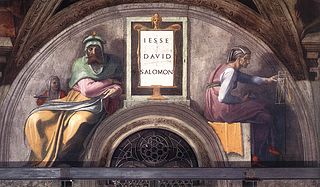 W
WMatthew 1:6 is the sixth verse of the first chapter of the Gospel of Matthew in the New Testament. The verse is part of the section where the genealogy of Joseph, the legal father of Jesus, is listed.
 W
WMatthew 1:20 is the twentieth verse of the first chapter in the Gospel of Matthew in the New Testament. Previously Joseph had found Mary to be pregnant and had considered leaving her. In this verse an angel comes to him in a dream and reassures him.
 W
WAccording to the Books of Samuel of the Tanakh, Mephibosheth was the son of Jonathan, grandson of King Saul and father of Mica or Micha.
 W
WAccording to the 1st Book of Samuel Chapter 25, Nabal, was a rich Carmelite, described as harsh and surly. He is featured in a story in which he is threatened by David over an insult, and ultimately killed by God.
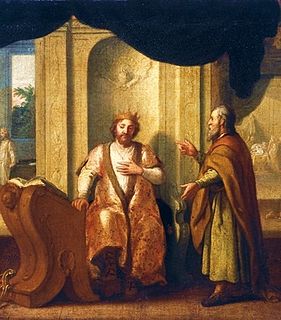 W
WNathan is a prophet in the Hebrew Bible. His actions are described in the Books of Samuel, Kings, and Chronicles.
 W
WThe Book of Psalms, commonly referred to simply as Psalms, the Psalter or "the Psalms", is the first book of the Ketuvim ("Writings"), the third section of the Hebrew Bible, and thus a book of the Christian Old Testament. The title is derived from the Greek translation, ψαλμοί, psalmoi, meaning "instrumental music" and, by extension, "the words accompanying the music". The book is an anthology of individual psalms, with 150 in the Jewish and Western Christian tradition and more in the Eastern Christian churches. Many are linked to the name of David. In fact, of the 150 Psalms, David is named as the author of only 75. David is specifically noted as the author of 73 psalms in the titles of the psalms but his authorship is not accepted by some highly critical modern scholars.
 W
WṢād is the 38th chapter (sūrah) of the Qur'an with 88 verses (āyāt) and 1 sajdah ۩ (38:24). Sad (ص) is the name of the eighteenth letter in the Arabic alphabet.
 W
WSaul, according to the Hebrew Bible, was the first king of the United Kingdom of Israel. His reign, traditionally placed in the late 11th century BCE, supposedly marked a transition from a tribal society to statehood.
 W
WThe Siege of Jebus is a siege described in biblical passages as having occurred when Israelites under King David of Israel besieged and conquered the Canaanite city of Jerusalem, then known as Jebus. The Israelites gained access by a surprise assault, making Jebus the capital of Israel under the new name, City of David.
 W
WThe Star of David, known in Hebrew as the Shield of David or Magen David, is a generally recognized symbol of modern Jewish identity and Judaism. Its shape is that of a hexagram, the compound of two equilateral triangles. The identification of the term "Star of David" or "Shield of David" with the hexagram shape dates to the 17th century. The term "Shield of David" is also used in the Siddur as a title of the God of Israel.
 W
WIn the Hebrew Bible, the witch of Endor is a woman Saul consulted to summon the spirit of prophet Samuel in the 28th chapter of the First Book of Samuel in order to receive advice against the Philistines in battle after his prior attempts to consult God through sacred lots and prophets had failed. The witch is absent from the version of that event recounted in the deuterocanonical Book of Sirach (46:19–20).
 W
WZiba (ציבא) is a man in 2 Samuel in the Hebrew Bible. He was a servant of Saul, and then later of Saul's grandson, Mephibosheth.